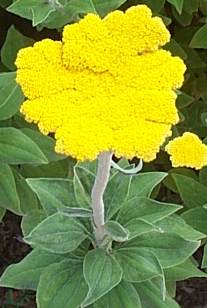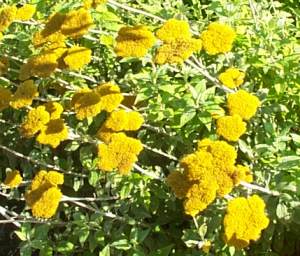Helichrysum umbraculigerum
Helichrysum umbraculigerum Less.
Family: Asteraceae
Common names: woolly umbrella helichrysum (Eng.); kerriekruie (Afr.)
Introduction
Helichrysum umbraculigerum was a relatively new addition to the herbaceous borders in Kirstenbosch in 2004. With its sulphur-yellow flowers and naturally long stems, it is a plant with great potential for most gardens.

Description
Description
Helichrysum umbraculigerum is a fast-growing, erect, perennial herb, reaching a height of ± 1 m and a spread of ± 1 m. It becomes woody with age. The leaf shape is extremely variable depending on its geographical distribution. According to Hilliard (1977) there are five very different leaf forms of this plant. The form growingin Kirstenbosch has ovate, untoothed leaves, 20-80 x 3-25 mm, witha long petiole (leaf stalk). The leaves are green above and slightly silvery and woolly on the underside. They become smaller upwards on the cobwebby, grey stems.
The flowers resemble large, flat, yellow umbrellas with a white woolly underside. They are irregular in shape and vary from 30-100 mm in diameter. Flowering time is in late summer, from late January to April. Flower heads become golden in colour as they age, remaining handsome for many weeks.

Distribution and habitat
Distribution description
The wide range of this plant stretches from the Eastern Highlands of Zimbabwe to the highlands of the Eastern Cape. It occurs in grasslands, forest edges and streambanks. The natural distribution implies a frost tolerant, summer rainfall plant.
Derivation of name and historical aspects
History
The genus name Helichrysum comes from the Greek (h)elios, meaning sun and chrysos, meaning gold; the Latin word umbraculigerum means, bearing woolly umbrellas.
The genus Helichrysum has 244 species in southern Africa with many noteworthy horticultural species. Mention 'everlasting' and most South Africans can immediately put a plant to mind! Several species, such as H.splendidum, H. populifolium and H. argryophylum have found their way into gardens.
Uses
Use
From the common Afrikaans name kerriekruie (meaning curry herb) it can be speculated that Helichrysum umbraculigerum has been used for culinary or medicinal purposes. Many other helichrysums such as H. nudifolium are used for their wound-healing and antifungal properties.
Horticulturally, this plant has uses as an excellent filler in herbaceous beds, flowering at a time when little else is colourful and as a cutflower it lasts for over two weeks in the vase.

Growing Helichrysum umbraculigerum
Grow
This plant naturally occurs in the summer rainfall areas of southern Africa, but can be successfully grown elsewhere, with moderate watering in summer. Planted en masse it produces a wonderful display of colour. It can also be used in herbaceous borders as a background filler. It is an excellent cutflower, producing up to 50 long stems per adult plant.
Helichrysum umbraculigerum must be grown in full sun or dappled shade. It requires a well-drained, loamy soil with added compost. In the winter rainfall areas, a good watering every 4 to5 in days in summer is sufficient.
Easily propagated from tip and stem cuttings, H. umbraculigerum is fast growing and will flower in its first summer. By year three it produces many long flower stalks. Cut back heavily in winter to prevent the plant from becoming too woody.
References
- Hilliard, O.M. 1977. Compositae in Natal. University of Natal Press, Pietermaritzberg.
- Hilliard, O.M. 1983. Asteraceae: Inuleae: Gnaphaliinae. Flora of southern Africa vol. 33, part 7, fascicle 2. Botanical Research Institute, Pretoria.
- Pooley, E. 1988. A field guide to wild flowers of KwaZulu-Natal and the eastern region. Natal Flora Publications Trust, Durban.
- Pooley, E. 2003. Mountain flowers. The Flora Publications Trust, Durban. Trish Hutton-Squire Kirstenbosch Garden Centre March 2004
Credits
Trish Hutton-Squire
Kirstenbosch Garden Centre
March 2004
Plant Attributes:
Plant Type: Perennial
SA Distribution: Eastern Cape, Free State, KwaZulu-Natal, Limpopo, Mpumalanga
Soil type: Sandy, Loam
Flowering season: Late Summer, Autumn
PH: Acid, Neutral
Flower colour: Yellow
Aspect: Full Sun
Gardening skill: Easy
Special Features:
Horticultural zones










Rate this article
Article well written and informative
Rate this plant
Is this an interesting plant?
User Comments
Omni , Netherlands
November 07, 2017 at 5:36 PMI would like to have some seeds of this plant.
Does anyone where to get them?
Greets, Omni
Login to add your Comment
Back to topNot registered yet? Click here to register.